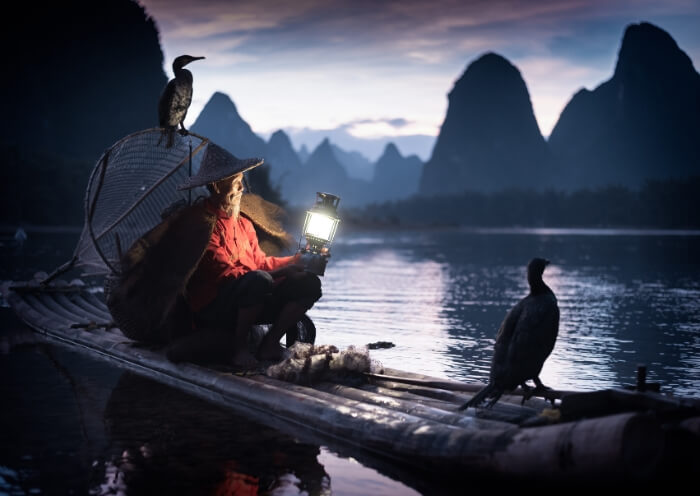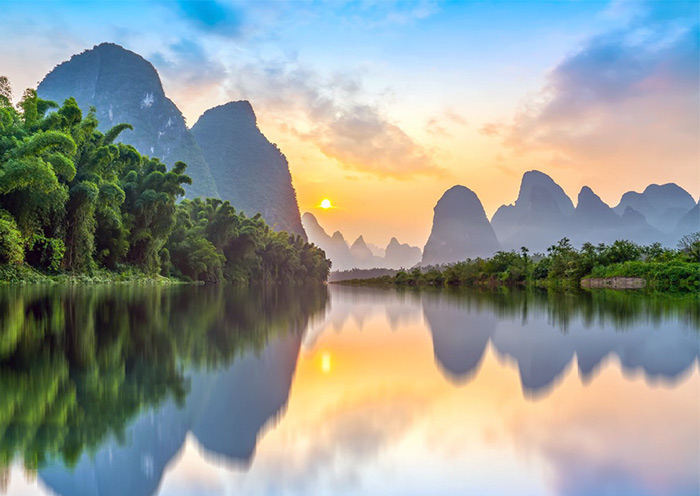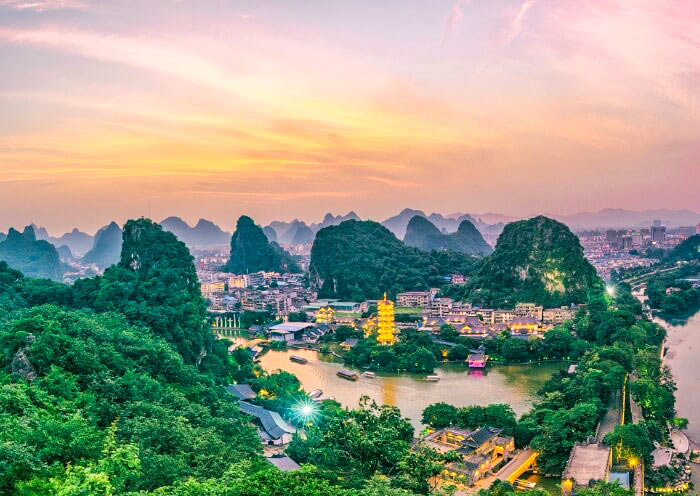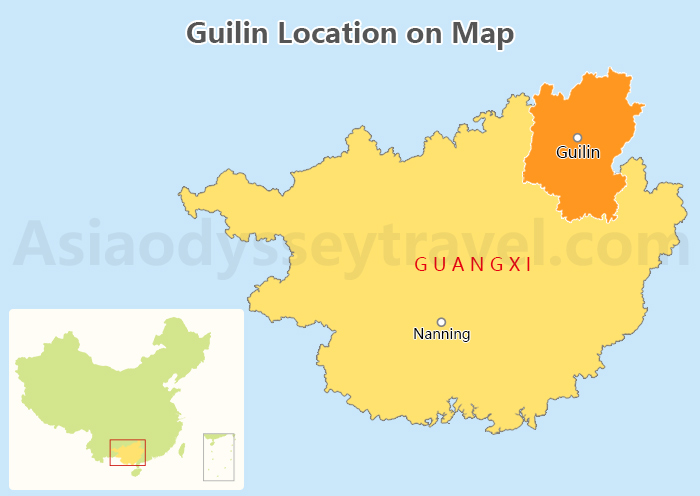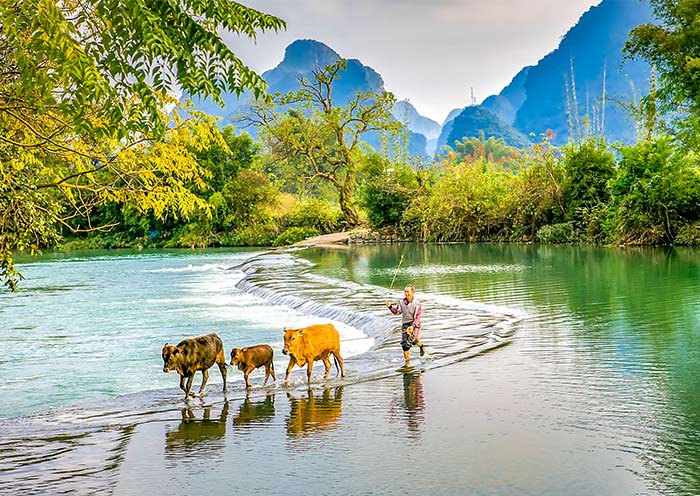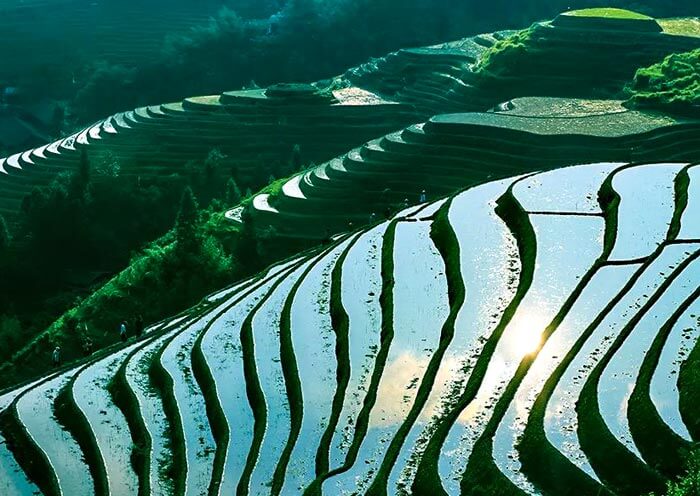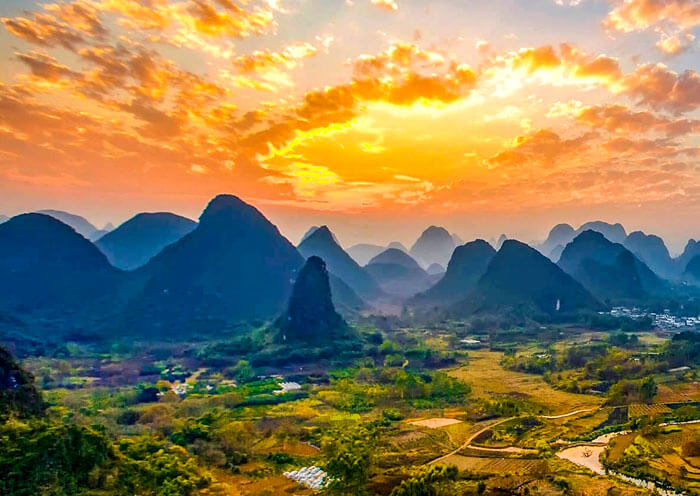Guilin Longji Rice Terraces: 4 Best Rice Terraced Fields
In fact, Longji Rice Terraces are a group of rice terraces consisting of mainly four parts: Ping'an Rice Terraced Fields, Jinkeng Rice Terraced Fields, Longji Ancient Zhuang Village Rice Terraced Fields, and Xiaozhai Rice Terraced Fields. Among them, Ping'an Rice Terraces and Jinkeng Rice Terraces are two must-visit terraced fields known for their stunning landscapes and convenient transportation.
No.1: Longji Rice Terraces: Ping'an Rice Terraced Fields (Ping'an Village)
Usually, when referring to the Longji Rice Terraces, it commonly pertains to the Ping'an Rice Terrace Fields, which were the first to be discovered by tourists and photographers. Located in Ping’an Village, Ping'an Rice Terraced Fields is the closest terraced fields to a major city (only a 2-hour drive from the city center of Guilin). As you walk across the cobbled paths of the Ping'an Rice Terrace Fields, you can reach its famous viewing platforms, such as the Seven Stars Accompany the Moon (880m, Sunrise Viewing Spot) & and Nine Dragons and Five Tigers (980m, Sunset Viewing spot). At the Nine Dragons and Five Tigers viewing platform (九龙五虎), you will see why it is named Longji Rice Terraces (Dragon Backbone Rice Terraces). In Chinese, “Longji” means “dragon's backbone”(龙脊), and when filled with water, the endless rows of rice terraces on the hillsides resemble the rippling scales on a dragon's backbone. The movie "Skiptrace"(绝命逃亡)starring Jackie Chan was filmed on location here.
As the earliest rice planting cycle, Ping'an Rice Terraced Fields consists of 15,862 terraced fields of various sizes with the steepest slope reaching 50 degrees. The largest terraced field covers only 0.62 acres, while the smallest can accommodate only three rice seedlings. It is said that "A frog can jump across three fields" and "A straw mat can cover a whole field", highlighting the compactness and small scale of these terraced fields. As you hike here, you may encounter misty landscapes, swirling clouds, sunrises, sunsets, and starry skies. Don’t forget to walk into the rice fields and experience the saying, "Every grain in the bowl is the result of hard work" (谁知盘中餐,粒粒皆辛苦), and immerse yourself in the authentic agricultural culture.
You can also walk into Ping'an Village along the stone-paved road, where you will find 170 households and over 700 people, all belonging to the Zhuang ethnic group with the surname "Liao". Men wear short gowns made of hand-loomed cloth, while women wear white shirts, black pants, and brightly colored cloth on their heads. Here, you can have a close-up view of the Zhuang people's distinctive stilted houses called "Diaojiaolou" (吊脚楼) in the mountain valley. You may encounter local Zhuang villagers, taste or make unique Zhuang People's food like oil-tea, have the opportunity to learn more about Zhuang ethnic customs and culture, as if you are transported to ancient times.

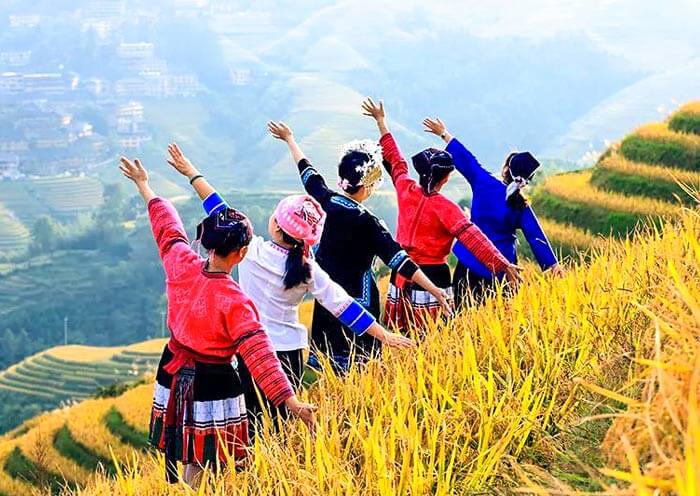
No.2: Longji Rice Terraces: Jinkeng Rice Terraced Fields (Dazhai Village)
Jinkeng Rice Terraces are must-visit terraced fields known for their stunning landscapes and convenient transportation. Located in Dazhai Village, Jinkeng Rice Terraces Fields are the largest of the four terraces fields of Longji and the only terraced facility with cable car. Jingken Rice Terraced Fields are the first choice for photographers. In Jingken Rice Terraced Fields, you will gain a deeper understanding of the marvel of agricultural art that the Longji Rice Terraces represent, including its sustainable development model known as "Upper forest, Lower field, and Dynamic Balance". Currently, the forest coverage of Dazhai Village is about 82%, which plays a role in conserving water sources while protecting the terraced landscape. This model is acclaimed as a living fossil and an engineering exemplar of soil and water conservation systems. You will see that terracing the fields like this not only reduces the chances of erosion but also helps to retain water as rice requires a lot of water to grow.
The scenery of Jinkeng Rice Terraced Fields has the largest scale, highest altitude, deepest valley, and the most magnificent scenery. In Chinese, “Jin” means “Gold”, “Keng” means “Sinkhole”. The Jinkeng Terraced Fields are named after the production of gold and are surrounded by mountains on all sides, resembling a natural sinkhole. The Jinkeng Rice Terraced Fields feature three best viewpoints: West Hill Music (西山韶乐; 1,180m, the highest spot for sunrises and sunsets), Thousand Layers to the Heavens (千层天梯; a sunset spot & photographer’s first choice), and Golden Buddha Peak (金佛顶; a sunrises spot with a panoramic terraces view). You can watch farmers working in the fields or rent a set of Yao ethnic group costumes and take pictures. It is also optional for you to take a 20-minute cable car ride from the Dazhai parking lot to Golden Buddha Peak instead of a 1-hour walk.
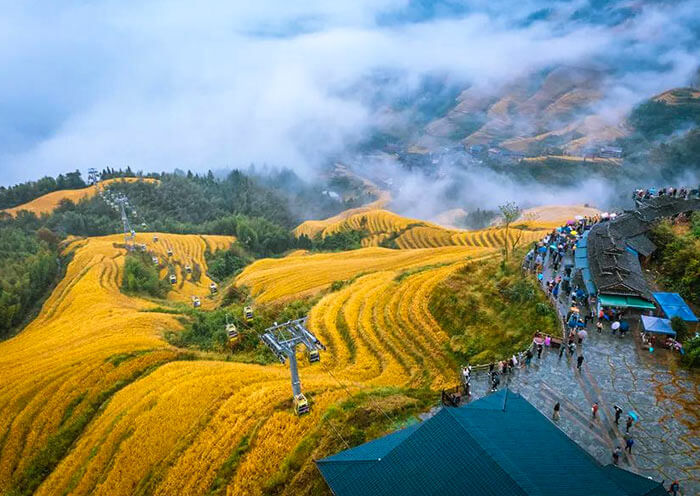

No.3: Longji Rice Terraces: Longji Ancient Zhuang Village Rice Terraced Fields
In comparison to Ping'an Rice Terraces, the Longji Old Zhuang Rice Terraces are less crowded and smaller, situated 5km away from Ping'an Village. You can enjoy the picturesque scenery of the Longji Old Zhuang Rice Terraces within 2 hours.
Located in Longji Ancient Zhuang Village, Longji Ancient Zhuang Village Rice Terraced Fields have preserved the original terraced landscape due to their remote location and relatively late development. The traditional stilted wooden houses distributed along the mountain ridge are a unique sight. During the visit, you can walk along the stone paved road, and admire the historical stone bridges, stone tablets, stone carvings, and other artifacts that tell the stories of the past.
The Longji Ancient Zhuang Village Rice Terraced Fields are situated at an altitude of over 600 meters. The ancient village is bathed in shimmering water and embraced by floating clouds, resembling a heavenly paradise. It becomes a stunning spectacle when combined with thousands of acres of terraced fields. The village is home to over 200 households and more than 1,000 people, predominantly of the Zhuang ethnic group with the surnames Pan, Liao, and Hou.
Every early spring, the terraced fields of the Longji Ancient Zhuang Village Rice Terraces are adorned with 500 acres of rapeseed flowers. In March, the golden yellow color of rapeseed flowers spreads from the mountainside to the valley of Longji Ancient Zhuang Village. The fragrance of rapeseed flowers permeates the air, creating a subtle scent that blends harmoniously with the unique stilted houses of the Zhuang ethnic group. It presents a beautiful and picturesque scene.
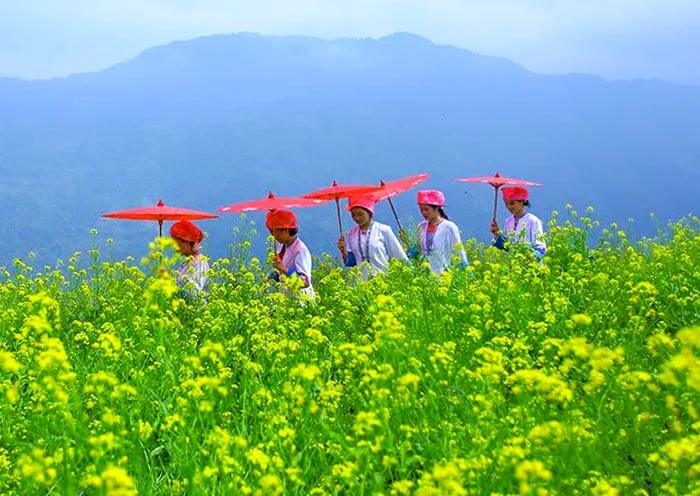
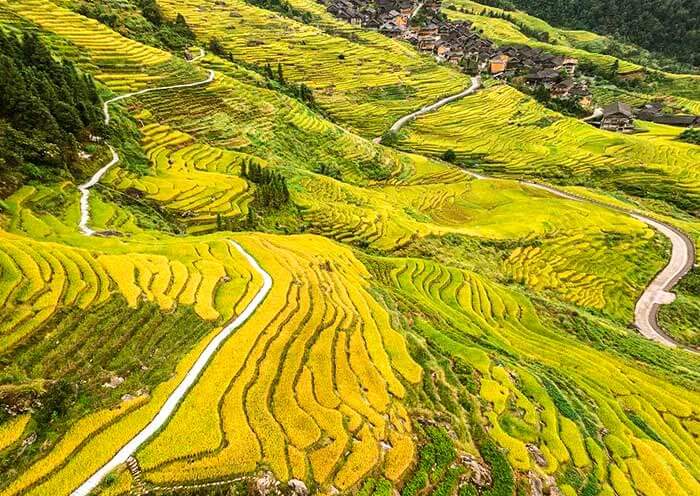
No.4: Longji Rice Terraces: Xiaozhai Rice Terraced Fields
Xiaozhai Rice Terraced Fields, located in Xiaozhai Village, Longji, currently consists of 308 households with a population of approximately 1,300 people. For hundreds of years, the ancestors of Xiaozhai have cultivated these terraced fields, ensuring their continuity. Situated deep in the mountains, Xiaozhai used to have limited transportation, allowing for the preservation of its ethnic characteristics and natural landscapes. Xiaozhai is one of the settlements of the Red Yao ethnic group, a branch of the Yao minority. The distinctive feature of the Red Yao people is their waist-length, shiny black hair and vibrant red embroidered attire, which has been included in the national intangible cultural heritage list. Yao women dressed in Red Yao clothing create a beautiful sight wherever they go.
Surrounded by terraced fields, Xiaozhai Village is marked by several ancient towering trees at its entrance, standing tall and verdant, serving as guardians and symbols of the village. The stone-paved road follows the stream, and stilted wooden houses line both sides of the stream. Stone bridges connect the banks of the stream, with a bridge every ten steps. Stone steps, stilted houses, flowing streams, and stone bridges form a tranquil and harmonious rural landscape, resembling a secluded paradise that captivates visitors.
You can visit the Xiaozhai Red Yao Costume Exhibition Hall, where, in addition to showcasing Red Yao attire, a vast collection of Red Yao production tools and daily utensils are on display, making it an ecological museum that presents the multifaceted aspects of the Red Yao culture in Longji.
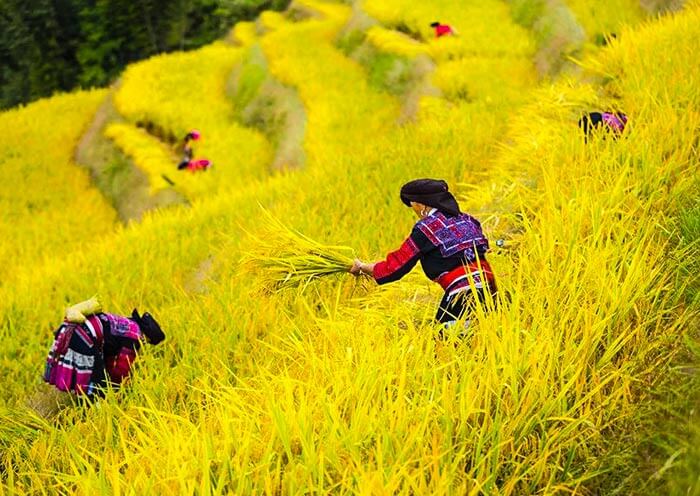
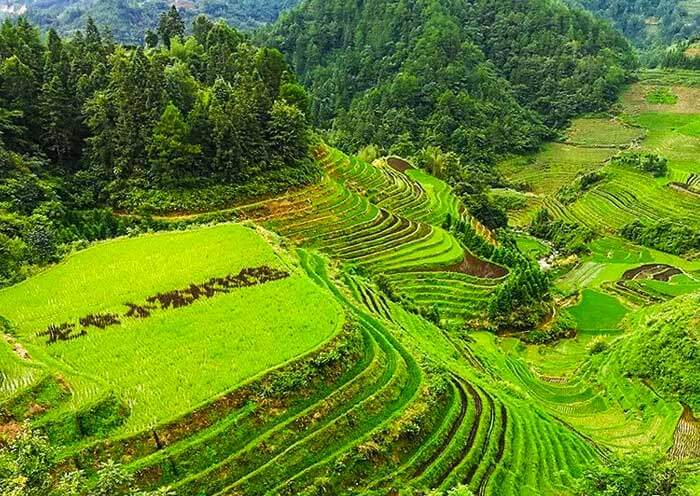
Best Time to Visit Longji Rice Terraces & Photograph Tips
When is the best time to visit Longji Rice Terraces? As one of the Top 10 most beautiful rice terraces in the world, a visit to Longji Rice Terraces will reward you with magical rice terraced fields that extend into the sky, amazing sunrises and sunsets, ever-changing seas of clouds, colorful ethnic groups, tasty traditional local food, unique Chinese painting-like scenery, pure countryside customs, wooden minority architectures, and more.
Throughout the seasons, the Longji Rice Terraces are a sight to behold, with layers of silver belts in spring, rolling waves of green in summer, towers of golden rice in autumn, and a scene resembling dragons playing in the water in winter. In fact, Longji Rice Terraces is worth a visit for each season and month, there is always something for you to capture.
Here are some tips for Photograph Longji Rice Terraces for your reference.
1). From mid-April to early June, during the irrigation period, the mirror-like terraced fields shimmer with reflections of mountains and clouds. It is a perfect time for capturing breathtaking sunrises and sunsets. The area is also known for its enchanting misty landscapes resembling a fairyland.
2).In May and June, during the rice planting season, you can experience the joy of rice transplanting and witness the ancestral farming labor. If you're lucky, you may encounter the Shuyang Festival, where you can immerse yourself in the customs of ethnic minorities.
3).From July to early September, during the lush green period, the rice fields are filled with vibrant green colors, as if stepping into a world of oil paintings.
4).From mid-September to mid-October, during the golden harvest period, the rice fields turn golden, and the waves of rice create a sense of joyous abundance.
5).From November to March, during the field maintenance period, if it snows in January, you can witness the terraced fields covered in a silver-white blanket, symbolizing the anticipation of a bountiful year.
6).From March to April, during the rapeseed flower season, some specific areas of the terraced fields are planted with rapeseed flowers. People wearing traditional ethnic costumes can be seen welcoming spring in the flower fields.
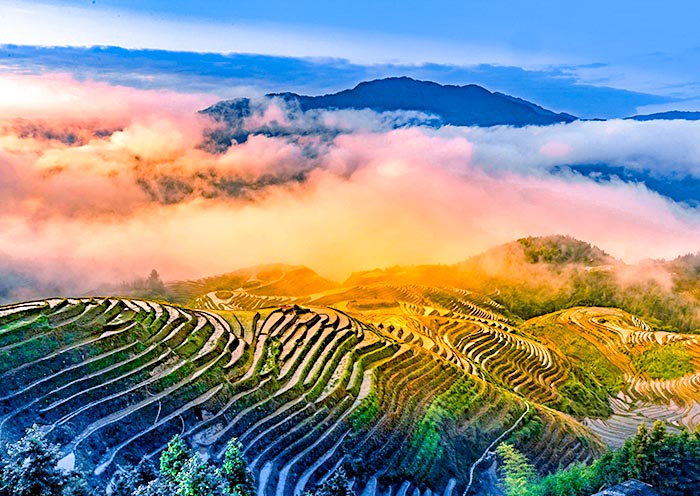
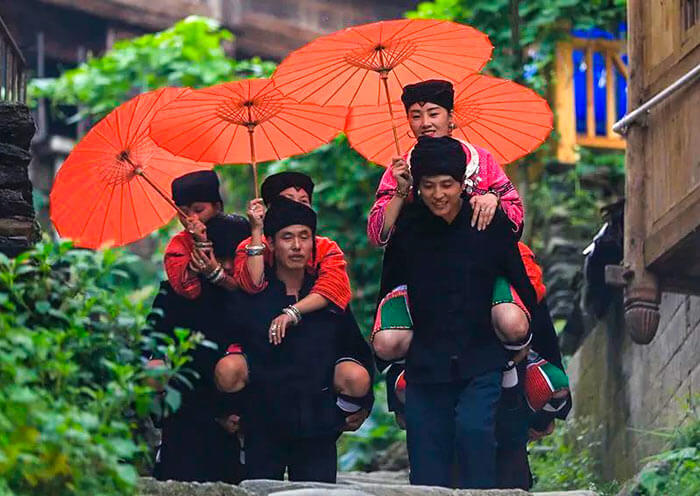
Hiking in Longji Rice Terraces & Hiking Tips
Hiking in Longji Rice Terraces is one of the must-do activities in Guilin. Take a Longji Rice Terraces hiking tour, you can explore the minority villages scattered among the rice fields, such as Huangluo Yao Village (Long Hair Village), Ping'an Village (Zhuang Minority), and Dazhai Village (Red Yao Minority). Try the unique cuisine of the local minority, including Rice Wine, Bamboo Rice, and Oil-tea. Visit their wooden and bamboo architecture and try the traditional clothing of the ethnic groups to gain a better understanding of Zhuang & Yao Minority Cultures.
It is a wise choice to spend your time hiking through different villages and terraced fields when visiting the Longji Rice Terraces, also known as Guilin Longsheng Longji Rice Terraces Wetland Park. With hiking in Longji Rice Terraces, you will gain a deeper understanding of the marvel of agricultural art that the Longji Rice Terraces represent, including its sustainable development model known as "Upper forest, Lower field, and Dynamic Balance".
You can spend one day on a Longji Rice Terraces Hike from Guilin to explore Ping'an Rice Terraced Fields, Huangluo Yao Village (Long Hair Village), and Ping'an Village (Zhuang Minority). You can also spend two days on a Longji Rice Terraces Hike from Guilin to explore Longji Rice Terraces from Ping'an Village to Dazhai Village for its Ping'an Rice Terraced Fields and Jinkeng Rice Terraced Fields. Contact us to start your Longji Rice TerracesHiking Tour.
No.1: Longji Ping'an Rice Terraced Fields Hiking Tips:
1).From Ping'an Village Parking Lot to Nine Dragons and Five Tigers, it takes about 0.5 hour's hike (2km).
2).From Ping'an Village Parking Lot to Seven Stars Accompany the Moon, it takes about 0.5 hours hike (2km).
3).From Nine Dragons and Five Tigers to Seven Stars Accompany the Moon, it takes about 0.5 hour's hike (2km).
4).The Longji Terraced Fields is located in the mountainous region, the weather can be unpredictable, so it is essential to have a raincoat with you.
5).Luggage Transport: It may take about one hour to walk from the parking lot to some of the hostels (no car road). The transportation of luggage requires the assistance of local villagers as porters, and the cost for this service is the responsibility of the visitors.
6).Staying overnight in a traditional wooden guesthouse is a unique experience, but be aware that conditions and services may not be on par with city hotels. Due to the rainy weather in the area, some guest rooms may have a musty odor.


No.2: Longji Jinkeng Rice Terraced Fields Hiking Tips:
1).From Ping'an to Dazhai Village, it takes 4-5 hours to finish the hike of 14 km.
2).From Dazhai Parking Lot to Golden Buddha Peak, it takes about 1.5 hour's hike.
3).From Dazhai Parking Lot to West Hill Music, it takes about a 2-hour hike.
4).Classic Hiking Route: Ping'an Village - Seven Stars Accompany the Moon - Nine Dragons and Five Tigers - Zhongliu Village - Thousand-Layer Terraces - West Hill Music - Tiantou Zhai - Golden Buddha Peak
5).Hiking difficulty: It is moderate and suitable for energetic people or hikers.
6).Avoid hiking on rainy days as the paths will be muddy. Part of the uncut stone paths even have many twists and turns, and some sections are steep.
7).Do follow your guide as there are a considerable number of small paths, which may easily lead to getting lost.
8).Late May and late September are the most popular times to go hiking and take photos.
9).For a hiking tour, it is better not to plan an itinerary that requires connecting with an airport or train station departure on the same day. If you want to catch a flight or train then you just take a car to Dazhai Village from Ping’an Village and use the round way cable car (20min for single way) to visit the Jinkeng Rice Terraces Fields.

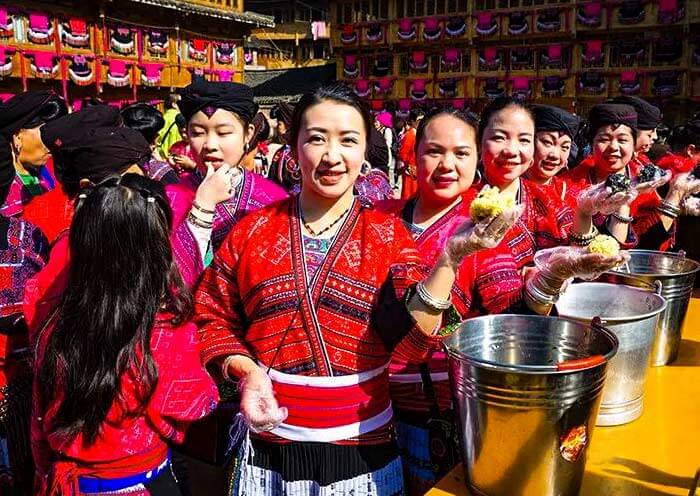
Ethnic Groups Festivels of Longji Rice Terraces
No.1: Huangluo Yao Village & Long Hair Festival
The tradition of Red Yao women keeping long hair here could date back to 1,000 years ago (Song Dynasty, 960-1276). Besides considering long hair as a precious treasure and a symbol of good luck, Yao women also like to wear red clothes, and the Red Yao ethnic group is named after this.
If you happen to visit during the third day of the third month of the Chinese lunar calendar, you can participate in the Long Hair Festival (三月三长发节) and witness the ancient and mysterious Red Yao young women's coming-of-age ceremony (at 17 years old). You will find that unmarried Yao girls cover their long hair with a headscarf and do not easily show it, while married Yao women wear their hair in a bun on top of their heads. The bun is made up of three parts: the hair that falls down from daily grooming (collected and saved over time), the hair that is cut during the coming-of-age ceremony (the only time in their life that they cut their hair), and the long hair that grows on their head (which can hang down to the ground).
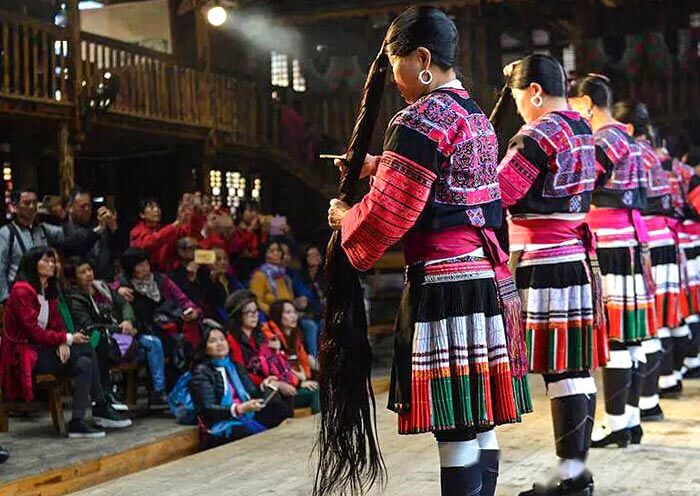
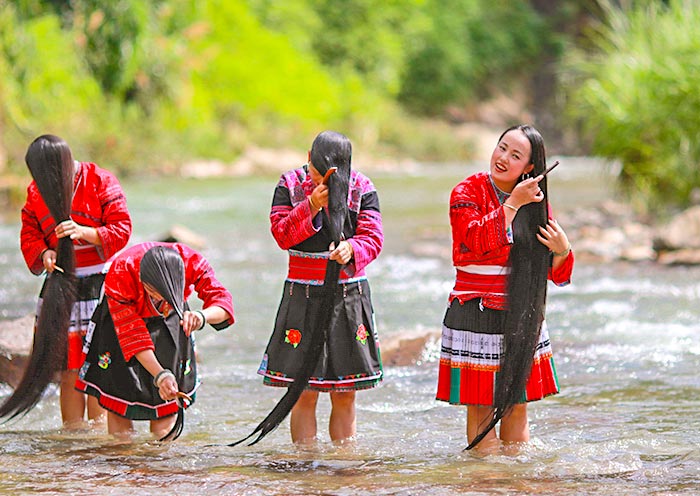
No.2: Ping'an Village & Shuyang Festival (Rice Transplanting Festival)
If you come to Dazhai Village during the Clothes Drying Festival (the sixth day of the sixth lunar month,六月六), you will have the opportunity to admire the long-haired Yao women hanging their traditional hand-made red clothes on the balconies. It takes 3 years to complete a set of Yao clothes. Yao costumes have been listed as a national-level intangible cultural heritage due to their exquisite embroidery skills and gorgeous embroidery patterns. Yao women do not need to draw sketches but rely on their experience to embroider flowers, trees, birds, and animals, which represent the Yao people's understanding of nature while expressing their yearning for a good harvest, a prosperous population, and a happy life. During the festival, there are Traditional Wedding Ceremonies, Long Hair Performances, Panhu Worship Activities (Panhu is the deified dog & Yao people's benefactor), Glutinous Rice Cake Making, Torch Night Show, and Bonfire Party for you to learn more about Yao ethnic group and their culture.
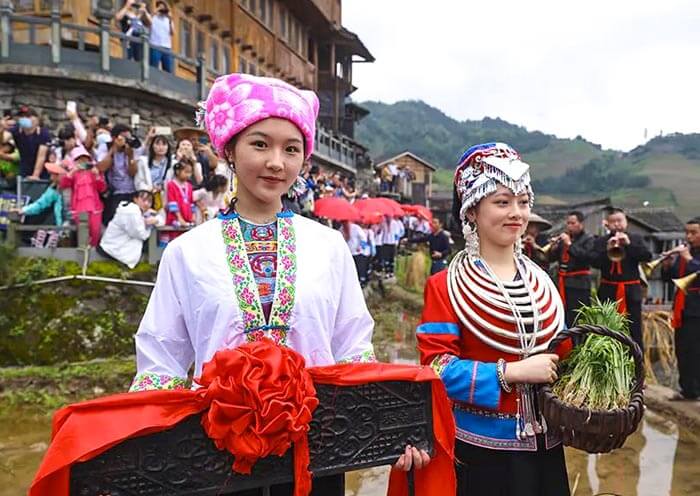
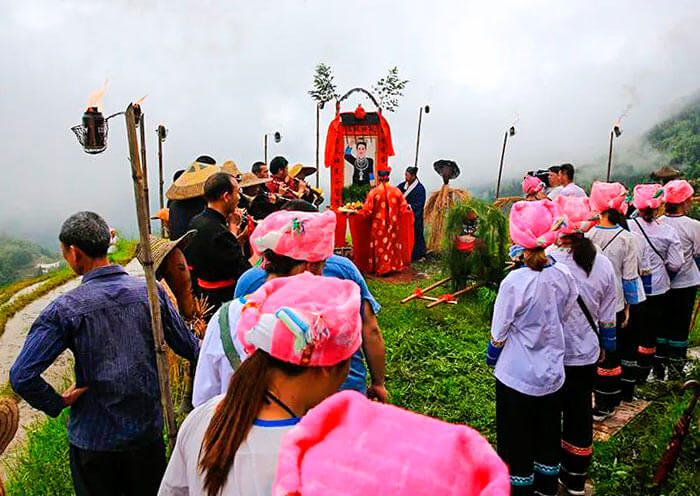
No.3: Dazhai Village & Clothes Drying Festival
If you come to Dazhai Village during the Clothes Drying Festival (the sixth day of the sixth lunar month,六月六), you will have the opportunity to admire the long-haired Yao women hanging their traditional hand-made red clothes on the balconies. It takes 3 years to complete a set of Yao clothes. Yao costumes have been listed as a national-level intangible cultural heritage due to their exquisite embroidery skills and gorgeous embroidery patterns. Yao women do not need to draw sketches but rely on their experience to embroider flowers, trees, birds, and animals, which represent the Yao people's understanding of nature while expressing their yearning for a good harvest, a prosperous population, and a happy life. During the festival, there are Traditional Wedding Ceremonies, Long Hair Performances, Panhu Worship Activities (Panhu is the deified dog & Yao people's benefactor), Glutinous Rice Cake Making, Torch Night Show, and Bonfire Party for you to learn more about Yao ethnic group and their culture.
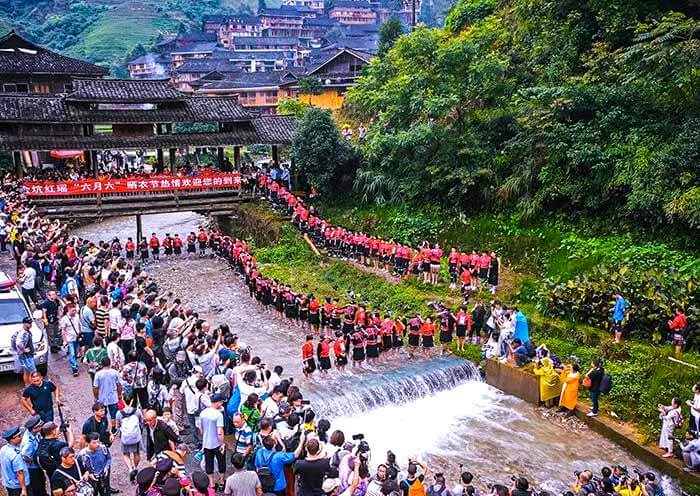
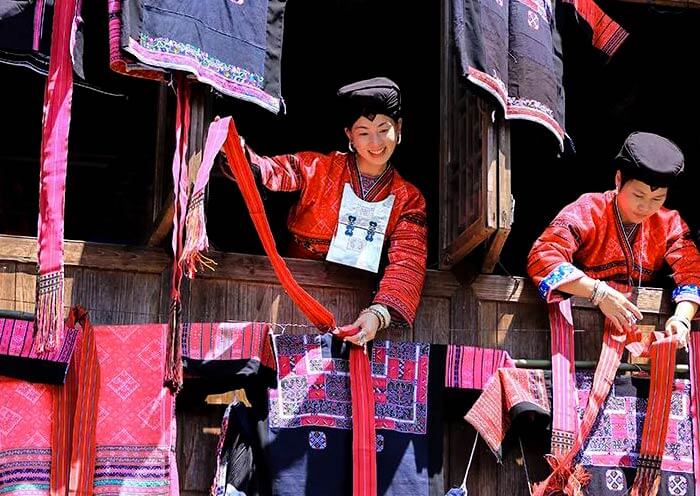
How to Plan a Longji Rice Terraces Tour?
Longji Rice Terraces is a must-visit destination in Guilin, Guangxi, for you to enjoy the Chinese painting-like countryside life with mountains and man-made wonders. Planning a Longji Rice Terraces Tour can be overwhelming, but with a little bit of research and preparation, you can make the most of your time in Longji and its sourounding area. However, to truly delve into the essence of this enchanting destination, it is highly recommended to spend 2 to 6 days for your Longji Rice Terraces Tour with Guilin, Yangshuo & Xingping. Here are the top 6 Longji Rice Terraces Tours for you. Join our tour, you will venture deep into the Longji Rice Terraces to capture sunrises and sunsets from various angles, encountering the mist-shrouded terraces and documenting the labor scenes of the indigenous Red Yao and Zhuang ethinic groups. Contact AOT Team to discover the marvels of Longji Rice Terraces.
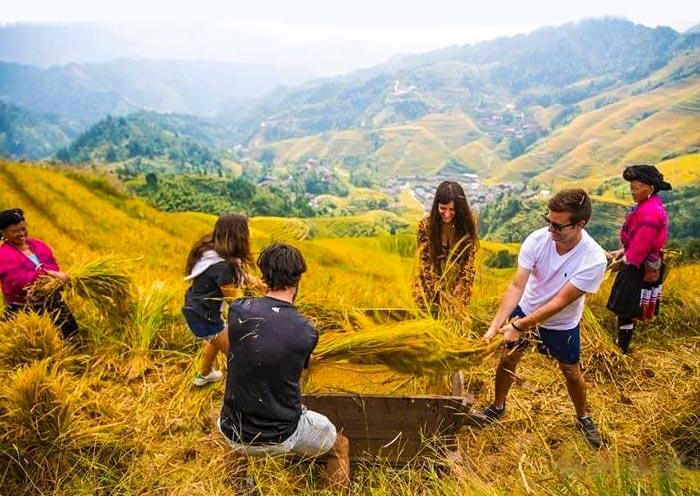

Explore Guilin/Yangshuo with Asia Odyssey Travel
Experience the breathtaking landscapes and tranquil beauty of Guilin with Asia Odyssey Travel (AOT), your expert guide through Asia’s most picturesque locales. Known for its stunning karst mountains and peaceful rivers, Guilin is a jewel in China’s scenic crown, and AOT is perfectly poised to tailor a journey that captures its unique essence.
Useful Guilin Travel Guide & Guilin Travel Tips:
Best Time to Visit Guilin, Things to Do in Guilin
How to Plan a Trip to Giulin, Things to Do in Yangshuo, Li River Guilin
Li River Cruise, Yulong River, Guilin Mountains, Longji Rice Terraces, Guilin Maps.
Guilin High Speed Train Guide:
Zhangjiajie to Guilin, Guangzhou to Guilin, Hong Kong to Guilin
Xian to Guilin, Beijing to Guilin, Shanghai to Guilin, Chengdu to Guilin
Tour Packages: Guilin tours, Li River Tours, Yangshuo Tours, Longji Rice Terraces Tours, Guangxi Tours
Contact us today to embark on a journey of discovery with Asia Odyssey Travel and let the enchanting scenery of Guilin unfold before you.

